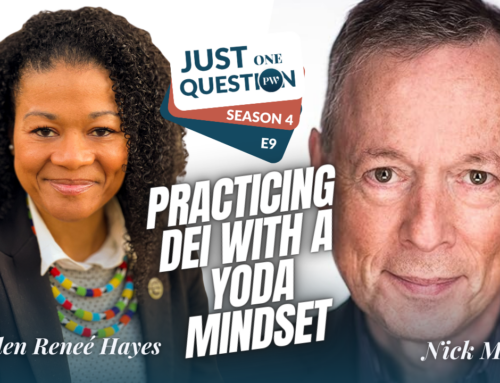Why tell stories in speeches? Because they are interesting, they help people remember what you say, and they are a good way to convey information and emotion memorably.
Mark Turner, a writer and philosopher who has been associated with the Institute for Advanced Study, and the Center for Neural and Cognitive Sciences at the University of Maryland, goes even further. In his landmark book, The Literary Mind, published by Oxford in 1996, he says, “Story is a basic principle of mind.” In other words, he argues that we think in terms of stories. We learn from the high chair that if we push a glass of milk over, white liquid spills on the floor, a parent comes running making noises, mops it up, and kisses us on the top of the head (if we’re lucky). That’s a story, and it’s a basic understanding of cause and effect by which we make sense of our world.
There are actors, actions, objects, and results. It’s all good fun, it’s memorable, and it’s how we continue to think long after we’ve left the high chair.
How does that apply to public speaking? Most people organize their talks in lists of information. (Five reasons to join our exciting investment program.) Unfortunately, the human mind is not constructed to remember lists very well. Once you’ve told me 3 or 4 things, to remember the 4th or 5th I’ll have to forget the first. ‘In one ear and out the other’ pretty describes how we respond to lists. Yet everyone who has heard, seen, or read it once remembers the story of Romeo and Juliet.
So if you give speeches more like Shakespeare and less like the phone book, you’ll be much more memorable. That’s why stories are important.
How do you create a great story for the purposes of public speaking?
My favorite structure for a persuasive speech is the problem-solution structure.
You begin by describing a problem that the audience has, and then you describe a solution. You can either hold to that structure, and tell stories at various points along the way, as examples and supporting evidence and so on, or you can treat the whole speech as a story.
Think of your stories as having three acts.
The first act presents an idea or a situation that will engage the audience (Romeo meets Juliet and falls in love). It’s best if this idea or situation is one that, once it has happened or been told, cannot be undone. (Romeo cannot ‘unmeet’ Juliet.) If you give your audience some information at the beginning of your speech that they don’t know, it has the same effect. (Our customer base has been eroding for the last 16 quarters, and just today I learned that it’s official — we’re now down for 17 quarters. We can’t afford to go on like this…).
Needless to say, it should be information that is of interest to the audience — it should be about a problem they have.
The second act raises the stakes on the earlier idea or situation. (Romeo marries Juliet despite the feud between the two families.) Once again, it should be something that cannot easily be undone. (If we have another down quarter, we’re going to have to close manufacturing plants in Chicago and Ohio.)
The third act precipitates a resolution, either favorable or unfavorable, by posing a question that must be resolved. (Romeo kills Tybalt in a duel, thus resulting in his banishment. Will Romeo and Juliet live happily ever after? Answer: no.) (To turn things around, I’m starting a new product line, code name Lemmings, that will excite customers once again and bring them flocking back to our stores.) Just as no one in the play Romeo and Juliet ever literally asks the resolving question out loud, you don’t have to in your speech. You do have to resolve it, and the best way is to get your audience to undertake some action to enlist them in your persuasive moment. (I’ve put prototype Lemmings underneath your chairs. I’d like you now to please take them out of their boxes and try them out.)
Just as the rest of Romeo and Juliet fills in around these key moments with scenes that explore the consequences of these interesting, fateful actions, your speech should too.
That’s the basic structure of a good story. But there’s more.
Western society contains a few basic stories that everyone knows and resonates to, so if you can invoke one of those stories, you’ll get instant buy-in from your audience.
For example, if you ask your employees to embark with you on a long and arduous journey to develop a new product, they’ll complain about the obstacles along the way, unless you invoke a Quest story. Then, the obstacles are to be expected because that’s what happens on a quest. The heroes (your audience) meet obstacles and suffer reversals — but eventually overcome them all to reach the goal. Don’t make the mistake of casting yourself as the lone hero — always bring the audience along with you.
The Quest story is the most basic one, and audiences get the idea very quickly because the story is so deeply ingrained in our psyches. Quest stories have heroes, journeys, obstacles, mentors, and most importantly a goal at the end. For more information on the subject, read Joseph Campbell’s The Hero with a Thousand Faces the definitive book on the subject.
After the Quest, the other fundamental stories are: Stranger in a Strange Land, Love Story, Rags to Riches, and Revenge.
The way to think about these stories is as thematic ideas that you invoke as you go through your speech. You might do it with a specific reference to a particular, well-known Quest story, like the Holy Grail, the Wizard of Oz, or Raiders of the Lost Ark, or you might use the elements and the language of a Stranger in a Strange Land story in order to bring the audience into that magical space without actually telling them bluntly that ‘you’re on a quest’. It’s better in this case not to be blunt, but rather to evoke the stories with their unconscious power to orient us and bring us into a space where we see the outcome as ordained by the structure of the story.
Once you’ve picked your thematic story and you’re off on a Quest or you’re all Strangers in a Strange Land, then you want to think about using archetypes to get further storytelling mileage out of our common mythology.
Basically, an archetype is a model of a character, or part of a character. The word and concept have been around for a long time, but they were made famous, so to speak, by the great Swiss psychologist Carl Jung.
When Jung talked about archetypes, he meant primarily aspects of a person — the Self, the Shadow (your Dark Side) and the Persona (the face you put toward the world). But he also talked about a host of other kinds of people, and aspects of people and the natural world, that could be archetypes, from the child, hero, mother and wise old man to the fish.
The idea is that your particular mother resonates for you with the archetypal mother in some ways, and not in other ways. You may develop a mother complex as a result. We live at our best and most fully when we’re in harmony with all the archetypes we summon up.
Jung believed that archetypes were real — a kind of bridge between our inner psychological world and the real world out there. More than that, we all have access to universal wisdom and understanding through and with these archetypes.
OK, so what does that mean for speakers?
I think we can invoke the power of the basic archetypes by naming them at appropriate moments in our stories and by using them as ways to connect with the audience. Words like ‘child’, ‘mother’, ‘father’ and so on have enormous resonance for just about everyone in your audience. The trick is to let your audience do the work, creating the associations, by giving them enough detail to get their minds working, but not so much that you stop them from using their imaginations.
Archetypes work best in simple stories that allow audiences to fill in the blanks. You need to craft these stories — really parables — with great care so that they are not hackneyed or silly.
If you do it right, you can create powerful, memorable stories — on a variety of levels — in your speeches that call us all to our best, archetypal selves and move your audiences to action.
For a great example of successful storytelling in a speech, watch Malcolm Gladwell’s TED.com talk on Howard Moskowitz, spaghetti sauce, and the platonic dish. Gladwell’s story artfully weaves together the food industry’s quest for understanding human food-eating behavior with a three-act drama about Howard Moskowitz’s search for the perfect spaghetti sauce. The result of the search will surprise you; in part because Gladwell has constructed the story so well, and in part because you may think you know what you want in a spaghetti sauce, but you really don’t.








[…] Depois de todas as dicas anteriores, é importante compilar tudo e criar uma ligação. A apresentação tem que ter um fio condutor, do princípio ao fim. Uma excelente maneira é contar uma história, criando personagens, por exemplo. Deves ser criativo e dar asas à tua imaginação. Sobre este ponto podes ler mais aqui. […]
[…] to our thinking: Stranger in a Strange Land, Revenge, Rags to Riches, and Love Story. You can look elsewhere in the archives for explanations of the stories and what they […]
[…] to our thinking: Stranger in a Strange Land, Revenge, Rags to Riches, and Love Story. You can look elsewhere in the archives for explanations of the stories and what they […]
Very helpful :-)
[…] speech. Don’t just skim the surface; get into the why behind each part. Think of your speech as a story — if you can explain the main points to a friend without glancing at your notes, you’re well on […]